|
|
|
|
|
|
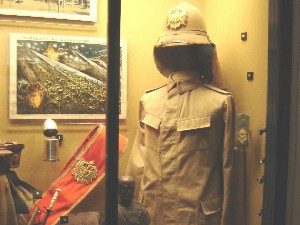 |
|
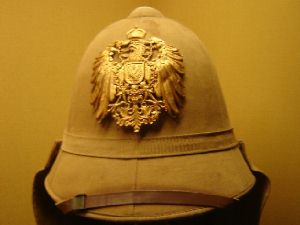 |
|
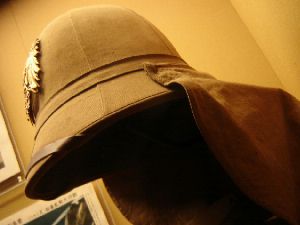 |
|
A display case containing the khaki
tropical uniform of an NCO of the 1st East Asian Infantry
Regt c.1901-04. This unit formed part of the East Asian
Expeditionary Corps and later the East Asian Occupation Brigade
until its disbandment in 1909. |
|
The East Asian issue tropical helmet. It
is a 1900 Bortfeldt helmet (see Tropical
Helmets Details Page) with a brass imperial eagle. Stocks of these same East Asian tropical helmets were
issued to some German troops in Palestine and Macedonia during the
First World War. |
|
A side view of the East Asian tropical
helmet showing the removable attachment of the neckshade. |
|
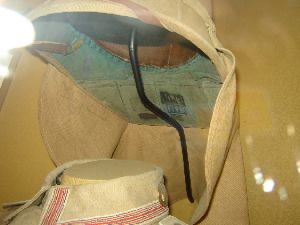 |
|
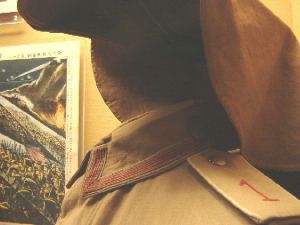 |
|
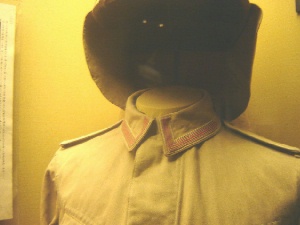 |
|
This photo shows the leather headband
and issue stamps inside the helmet. Note the folding crease across the
rear peak. NCO rank insignia is in the form of black/white/red collar
lace with a large brass collar button bearing an imperial eagle,
denoting his rank as a Sergeant. |
|
A closer look at the collar and shoulder strap.
The stiffened shoulder board is piped in white for infantry and bears
the red numeral 1 for the 1st East Asian Infantry Regt. |
|
Another view of the East Asian uniform
showing the concealed button front. |
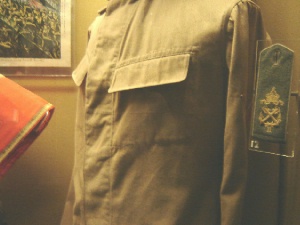 |
|
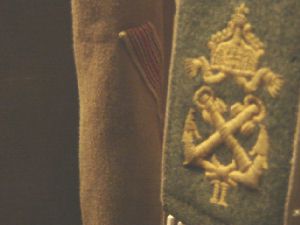 |
|
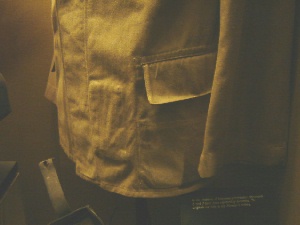 |
|
This photo shows the sloped breast
pockets of the East Asian uniform again with concealed buttons. |
|
In this photo the left arm rank chevron of
the East Asian uniform is just visible behind a shoulder strap from
the M1910 field grey uniform of the II. Seebataillon. East Asian NCOs
of all ranks were authorised to wear a single chevron on the left
arm from 1901. The rank chevron
itself is made of the same lace as the collar.
|
|
Another photo of the East Asian uniform,
this time showing the hip pockets with concealed buttons and the plain
cuff. |
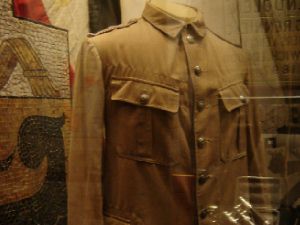 |
|
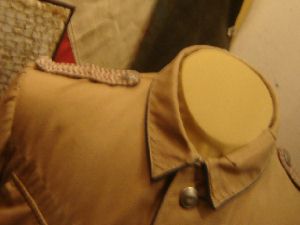 |
|
 |
|
This photo shows a Schutztruppe other
ranks tunic from South West Africa, very similar to the one on the
Schutztruppe Khaki Uniform Details Page (see there for full
description). Identical tunics were worn by the German other ranks in
East Africa and Cameroon. |
|
A closer look at the blue-piped collar and
black/white/red shoulder straps of the Schutztruppe tunic. |
|
Another look at the Schutztruppe tunic.
Note the breast stitching and sloped pockets. |
 |
|
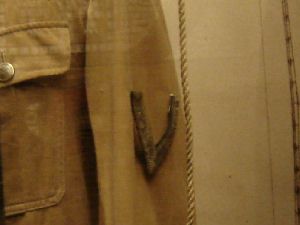 |
|
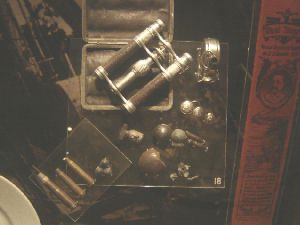 |
|
A close up of the Schutztruppe tunic's
blue piped collar and white metal buttons. Curiously although being
otherwise identical to most Schutztruppe buttons, the buttons on this
tunic bear the Royal Prussian crown rather than the Imperial German
crown usually seen on Schutztruppe tunics. |
|
The left arm of the Schutztruppe tunic
showing the single rank chevron of a Corporal or Unteroffizier. |
|
A collection of items captured from the
Germans in East Africa including a pair of opera glasses used as
binoculars, a pocket camera, several Schutztruppe white metal tunic
buttons with the imperial crown, a beer tap from the SMS Königsberg,
some pieces of shrapnel and three cartridges from a Mauser 7.9mm,
British Lee Enfield .303 and a Mauser 11mm. |
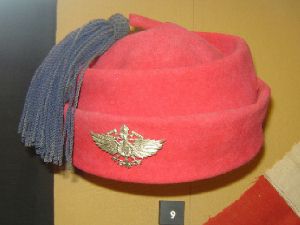 |
|
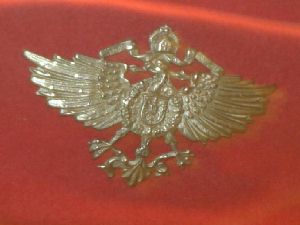 |
|
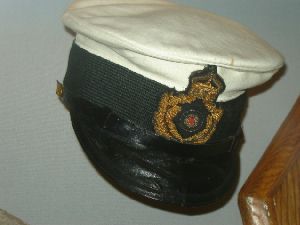 |
|
A Cameroon Schutztruppe African Soldier's Fez with white
metal eagle and black tassel. Note how the fez is worn rolled down. The
German term for this kind of headgear is appropriately a "Rollfez".
Although we can't see the underside of the fez on display at the
museum another example has been seen with the issue stamp "KA 1906"
(for Kamerun or possibly Kolonial-Amt and date of issue) similar to those on other German
issued equipment. |
|
A close up of the white metal eagle on the
Cameroon fez. The fez would have been identical for the Cameroon Polizeitruppe
but for the eagle being brass rather than white metal as shown here
worn by the
Schutztruppe. |
|
A German naval officers white summer
cap. Note the embroidered black/white/red cockade, gold wreath and
imperial crown on the front. |
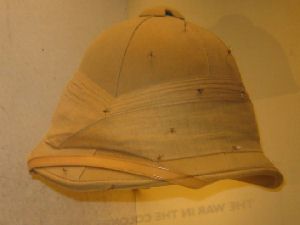 |
|
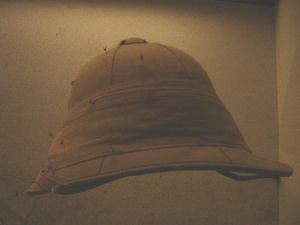 |
|
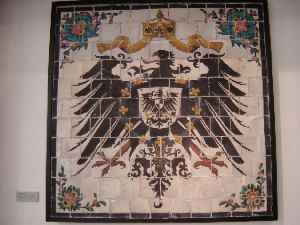 |
|
A British Wolseley Tropical helmet
worn in the Middle East during the First World War. This was the most
commonly issued tropical helmet to the British forces serving on all
fronts overseas in the First World War. It was also popular with the German
Schutztruppe in East Africa when captured, sometimes with the addition
of a black/white/red cockade. Von Lettow-Vorbeck himself even wore
one. This particular example has had insects added by the museum as
part of the display. |
|
A side view of the British
Tropical helmet. |
|
A decorative imperial German eagle that
was removed from the walls of a German residence in Baghdad by British
troops. |
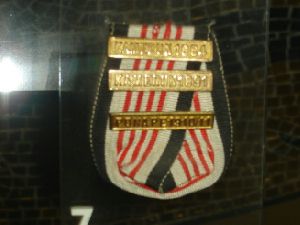 |
|
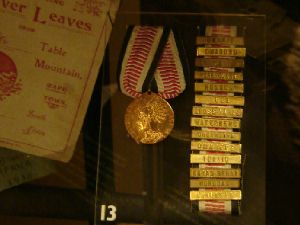 |
|
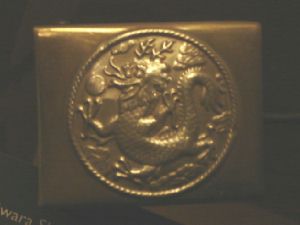 |
|
A ribbon with bars of the German
Colonial Medal. This medal was issued to all combatants and
non-combatants in German Colonial campaigns. The medal itself was
similar in appearance to the German South West African medal (See
Medals Details Page) and was also
issued in bronze for combatants and white metal for non-combatants.
The ribbon differs only in that the centre red bars are vertical
stripes rather than horizontal chevrons. Brass bars have been added to
this ribbon for additional campaigns, in this case for the risings in
Cameroon (or Kamerun in German as here) in 1884 and 1891, and the
rebellion of the Sokehs people on Pohnpei (or Ponape in German) in New
Guinea 1910-11. |
|
A South West African Medal with
campaign bars on the ribbon. It is unlikley that these were all earned
by a single soldier. The bars are for the campaigns: Oranje, Omaruru, Gross-Namaland, Hereroland, Nossob, Allob, Gross-Nabas,
Waterberg, Ongajira, Omaheke, Toasis, Káras-Berge, Nurudas and
Fahlgras. |
|
A Chinese Dragon Belt Buckle. The
Chinese Dragon belt buckle was a source of some debate until the
mystery was finally solved in an article entitled "China-Waffen"
at
Traditionsverband. They were in fact made in in the
19th Century in Germany for export to the Chinese Army along with
similarly decorated swords. German forces found Chinese prisoners at
the Taku Forts in 1900 bearing such items. So it seems that they were
not intended for use by Chinese troops in German service as myself and
others had previously thought. It is nonetheless a very interesting
and collectable item.
This buckle is made from one piece of
stamped brass rather than the usual two piece metal belt buckles of
the German army of the time. Other examples of the Dragon belt buckle
are made from two pieces of metal. |
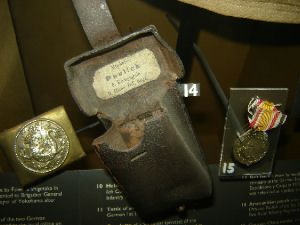 |
|
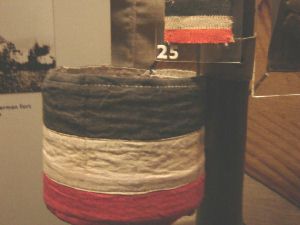 |
|
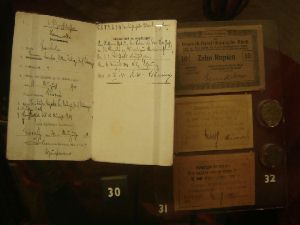 |
|
A collection of German Militaria from
China. On the left is the Chinese belt buckle. In the centre is a
cartridge pouch issued to Musketeer Paulick of the 5th Company, 2nd East
Asian
Infantry Regiment. On the right is a China Campaign medal (See
Medals
Details Page) |
|
An Armband and Ribbon from East Africa
in German imperial colours for sewing onto the uniform to aid in
identification. These items were captured during the First World War.
|
|
A set of Documents, banknotes and coins
captured from the Germans in East Africa during the First World War. |
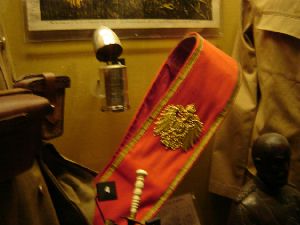 |
|
 |
|
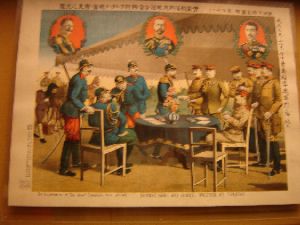 |
|
A Samoan Fita Fita Sash worn for
ceremonial duties. Note that although the eagle is pinned in line with
the sash itself on this display, contemporary photographs show the
eagle was usually worn upright. This sash was captured by New Zealand forces in at
Apia in 1914. |
|
A close up of the brass imperial eagle on
the Samoan sash. |
|
A Japanese illustration of the the
German surrender at Tsingtao. The artist was clearly not an
eyewitness of the event as the imaginative pickelhaubes, blue tunics and red
trousers worn by Major Waldeck and his staff show. |
|
|
|
Some other items at the Museum include... |
|
|
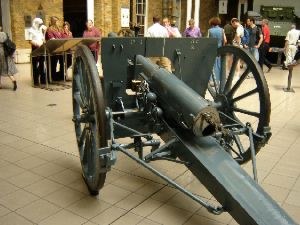 |
|
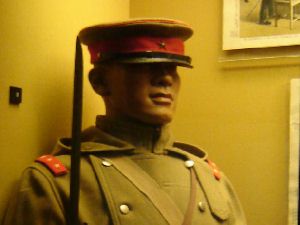 |
|
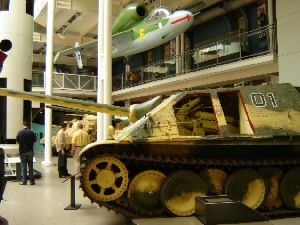 |
|
A French 75mm field gun c1914 |
|
Japanese Infantry uniform as worn at the
Siege of Tsingtao in 1914 |
|
Cut-away view of a Jagdpanther SP gun with a Heinkel 162 jet plane
overhead. |
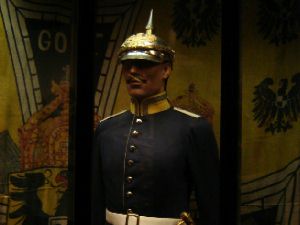 |
|
 |
|
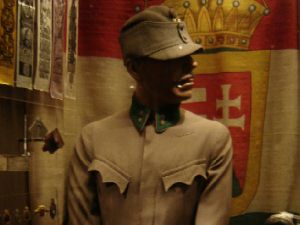 |
|
A German
Kürassier uniform c1900 |
|
A London bus used on the Western Front in
1914. |
|
An Austro-Hungarian Jäger NCO uniform |
|
|
|
|
|
|